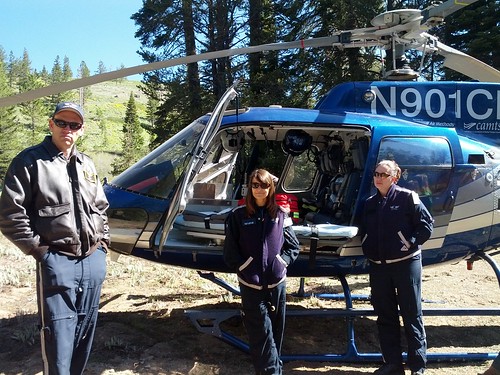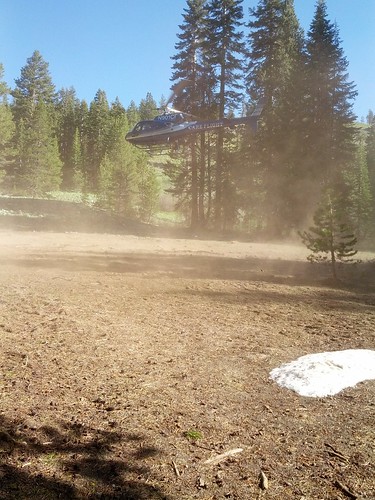Medivac helicopter landing
2013-05-23
I've been taking a WFR course (Wilderness First Responder) up in Donner pass with Bobbie Foster. We're about halfway through now.
Yesterday was our day off. As part of the day off Bobbie had organized with CareFlight to do a wilderness landing and chat with us for a while. Super cool!

Another member of our WFR class had some training in landing in helicopters, so she took did the comms stuff, double-checked the coordinates and that sort of thing. I brought my radio as a backup, so I was able to listen in. The day was perfect and the air was nearly still so there wasn't much radio chatter, just an initial call and response, then the copter landed.

I actually learned a *lot* from talking with them. Normally they'd be landing in a place they hadn't been before, but this same pilot landed here last year for this class - which meant he already knew the location. If he didn't then the point person for the landing would've been telling the pilot where the landing zone was relative to his position on a clock face once she caught site of the 'copter. This would help him find us. Then that point person would stand on the edge of the field, but visible in front of the heli as it came in, and give the pilot any additional info he asked for, things like wind speed and direction at ground level. They might also tell the pilot about potential hazards like a power-line near-by or a tree that's in the way, just to ensure the pilot is aware of them.
For snow landings, they actually like to land almost on-top of the point person. As they land that person will turn around and crouch, they'll land literally like 2 feet behind that person. This way as the snow shoots up all around the helicopter the pilot has something to focus on to keep the hover in the right spot as he lands, otherwise it's hard to stay steady apparently.
The pilot said that they can land in basically any 100ft x 100ft patch (he had more exact numbers, but it's not that important, point being if it's close to that big, he'll make it work). There needs to be level'ish ground, but he said he'd also landed in boulder fields before. So basically, don't second guess the pilot, they'll figure it out. They are largely limited by visibility, though temperature can also impact the lift the heli can generate. They actually mentioned that if you tell them the approximate weight of the patient, and temperature at your location it can help them gauge fuel appropriately, especially if it's high elevation, a hot day, and a heavy patient.
Interestingly, apparently they do fly at night with night-vision goggles. The team that landed consisted of a pilot, a nurse and paramedic. Apparently the nurse and paramedic actually also wear the night-vision goggles to help the pilot with difficult manuvers at night.
I didn't get good photos of the inside of the helicopter, but basically there's the pilot's seat, the two seats for the medical staff, and the stretcher for the patient. They have basically all the equipment an ICU would have, pumps for drugs, heart monitors, AED, the whole shebang. They've got survival kits in case they have to stay with a patient.
About half their missions are inter-hospital transports and half are scenes. Occasionally though they do things that aren't medical at all like transport SAR dog teams. Being located near Donner pass (we were a 6 minute flight) they obviously do a lot of ski-resort pickups, though the mentioned that a huge portion of their calls are snowmobiles in the winter, and ATVs in the summer - often involving alcohol.
Apparently 'copters that long-line are in a separate class from medivac 'copters like this one. A long-line is when they have a long cable strung under the helicopter that they lower down to the ground to lift loads (like a patient in a stretcher). This technique is only used when you can't get the patient to a reasonable landing zone. This 'copter then doesn't do that, they land and take the patient on board if they take the patient.
It's hard to imagine how sweet this sight would look if you've got a midline femur fracture or a nearly bursting appendix and are freezing in the snow 3 days skiing to the nearest road:
 More photos
https://secure.flickr.com/photos/smalladventures/with/8791524799/
More photos
https://secure.flickr.com/photos/smalladventures/with/8791524799/

